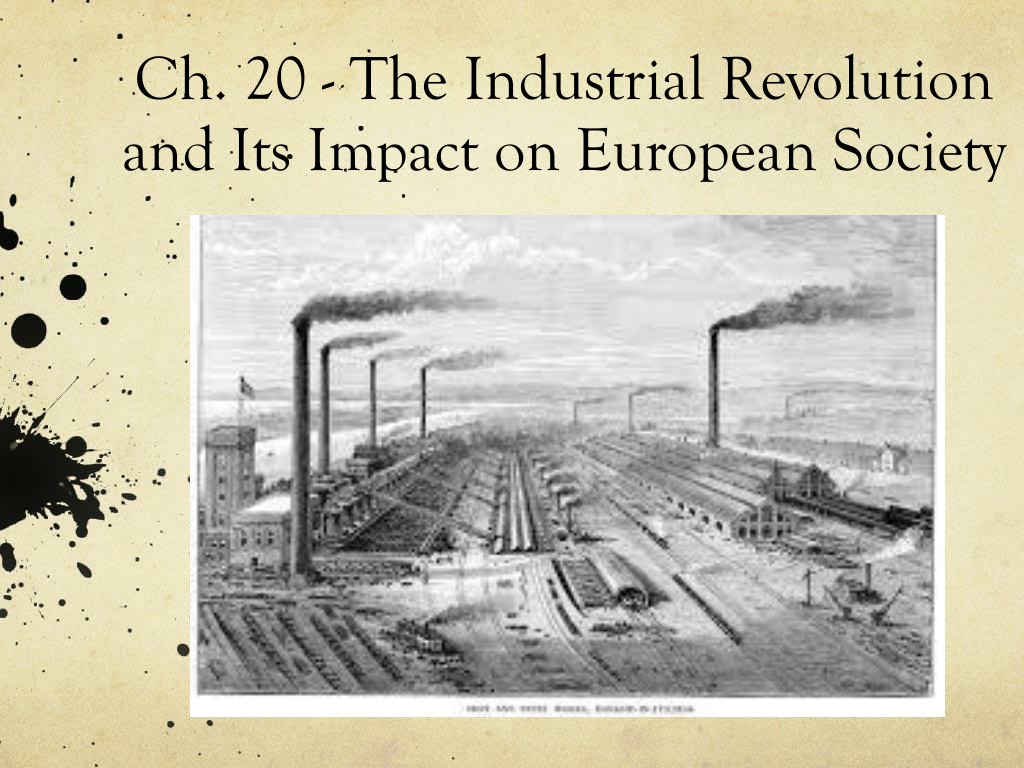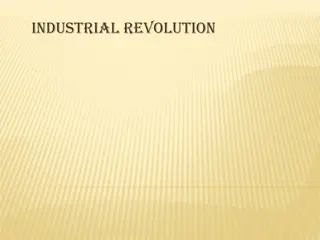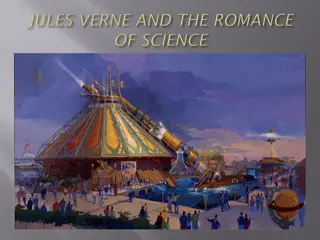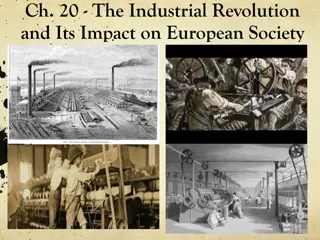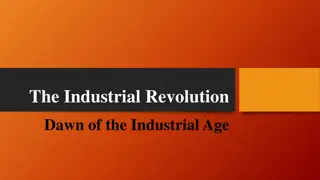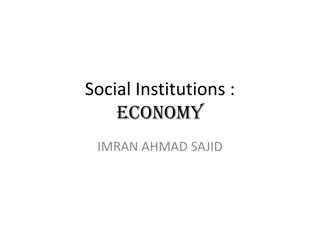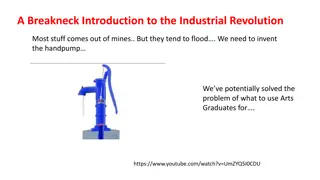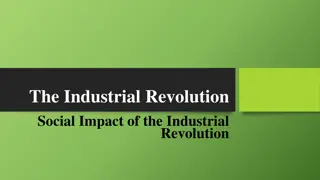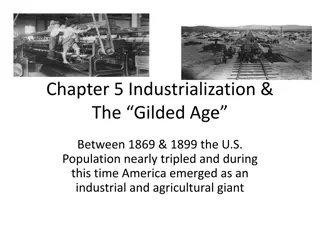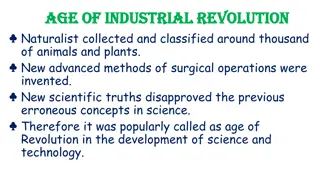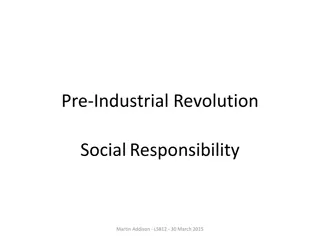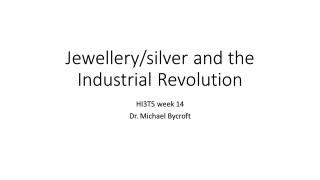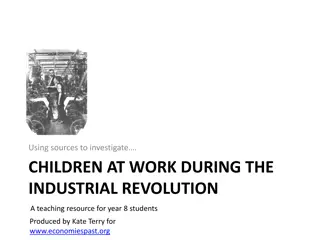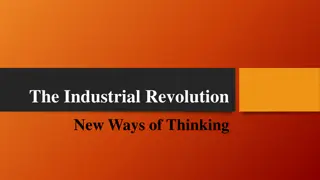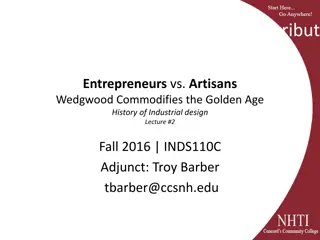Impact of Industrial Revolution on European Society
The Industrial Revolution had a profound impact on European society, characterized by key terms such as Agricultural Revolution, Capital, Pig Iron, Wrought Iron, Tariffs, Cholera, and Trade Unions. This period saw advancements in agricultural techniques, the rise of material wealth for production, the development of different types of iron, the imposition of tariffs, the prevalence of deadly diseases like cholera, and the formation of trade unions to advocate for workers' rights.
Download Presentation

Please find below an Image/Link to download the presentation.
The content on the website is provided AS IS for your information and personal use only. It may not be sold, licensed, or shared on other websites without obtaining consent from the author. Download presentation by click this link. If you encounter any issues during the download, it is possible that the publisher has removed the file from their server.
E N D
Presentation Transcript
Ch. 20 - The Industrial Revolution and Its Impact on European Society
Ch. 20 Key Terms Agricultural revolution (p. 593) the application of new agricultural techniques that allowed for a large increase in productivity in the eighteenth century. Capital (p. 593) material wealth used or available for use in the production of more wealth. Pig iron (p. 596) a type of iron produced by smelting iron ore with coke; of lower quality than wrought iron. Wrought iron (p. 596) a high quality iron first produced during the eighteenth century in Britain; manufactured by puddling, a process developed by Henry Cort that involved using coke to burn away the impurities in pig iron. Tariffs (p. 601) duties (taxes) imposed on imported goods, usually to raise revenue and to discourage imports and protect domestic industries. Cholera (p. 609) a serious and often deadly disease commonly spread by contaminated water; a major problem in nineteenth-century European cities before sewerage systems were installed. Trade unions (p. 615) associations of workers in the same trade formed to help members secure better wages, benefits, and working conditions.
Agricultural revolution (p. 593) the application of new agricultural techniques that allowed for a large increase in productivity in the eighteenth century.
Capital (p. 593) material wealth used or available for use in the production of more wealth.
Pig iron (p. 596) a type of iron produced by smelting iron ore with coke; of lower quality than wrought iron.
Wrought iron (p. 596) a high quality iron first produced during the eighteenth century in Britain; manufactured by puddling, a process developed by Henry Cort that involved using coke to burn away the impurities in pig iron.
Tariffs (p. 601) duties (taxes) imposed on imported goods, usually to raise revenue and to discourage imports and protect domestic industries.
Cholera (p. 609) a serious and often deadly disease commonly spread by contaminated water; a major problem in nineteenth-century European cities before sewerage systems were installed.
Trade unions (p. 615) associations of workers in the same trade formed to help members secure better wages, benefits, and working conditions.
The Industrial Revolution in Great Britain FQ: Why was Great Britain the first state to have an Industrial Revolution? Why did it happen in Britain when it did? What were the basic features of the new industrial system created by the Industrial Revolution?
Origins of the Industrial Revolution in Great Britain Agricultural revolution Supply of capital Early industrial entrepreneurs Mineral resources Role of government Markets https://www.youtube.com/watch?v=ut0rX2MngL8&t=1s (Intro. to Industrial Revolution in Great Britain)
Supply of capital Profits from trade and cottage industry Great Britain possessed an effective central bank and well- developed, flexible credit facilities. Factory owners were former merchants and entrepreneurs who had profited from the 18th century cottage industry.
Early Industrial Entrepreneurs The British were a people fascinated by wealth and commerce, collectively and individually . The Glorious Revolution of 1688 helped create an environment much more supportive of innovation in economic matters compared to the rest of Europe. Fortunes were made and lost.
Mineral Resources Britain had large supplies of coal and iron ore, both used during the manufacturing process. Abundant rivers in addition to both private and public investment put into the construction of new roads, bridges and canals allowed for resources to be transported more efficiently.
Role of Government British parliament passed laws that protected private property and encouraged private enterprise. Great Britain was the the least restrictive on private entrepreneurs throughout Europe.
Markets British exports quadrupled between 1660-1760. Great Britain had established a colonial empire with markets in the Americas, Africa and the East. Demand from both domestic and foreign markets and the inability of the old system to meet that demand led entrepreneurs to seek and adopt the new methods of manufacturing.
Technological Changes and New Forms of Industrial Organization Cotton Industry Steam Engine Revolution in Transportation Iron Industry
The Cotton Industry Development of new machines (flying shuttle, spinning jenny, Crompton s mule) gradually replaced skilled workers and produced cotton at a much more efficient rate. Concentration of factory labor led to urbanization. High demand for cotton throughout Europe led to even more innovation to increase productivity.
The Steam Engine Revolutionized the production of cotton goods and allowed the factory system to spread to other areas of production leading to new industries. Created by James Watt (1736-1819) in the 1760s. An engine powered by steam that could pump water from mines.
Iron Industry New methods of smelting iron ore to produce cast iron were created using coke or courke that was made by slowly burning coal. 1870s Henry Cort developed a process called puddling in which coke was used to burn away impurities in pig iron to produce an iron of high quality called wrought iron. Wrought iron was lower in carbon content, malleable and could withstand more. Demand for the higher quality iron caused a boom between the 1740s and 1780s.
A Revolution in Transportation Vast network of roads, canals, and railways were established to create the most efficient system of production and distribution of goods. Development of the steam engine led to a radical transformation of the railways, drastically improving travel time.
1804 first steam-powered locomotive on an industrial rail line in southern Wales traveled up to 5 mph. 1830 Stephenson s Rocket was first public railway line that extended 32 miles and traveled at 16 mph. 1850s locomotives reached 50 mph and changed perceptions of time, space and nature.
The Industrial Factory Factory owners could not afford to let their expensive machinery sit idle which forced workers to work long, regular hours . Factory owners were focused on being as efficient as possible to create as much wealth as possible with little regard for worker s rights or healthy work conditions.
Britains Great Exhibition of 1851 World s first industrial fair at Kensington in London in the Crystal Palace which was made of only glass and iron. Purpose of the fair was essentially to show off their material success to the world.
